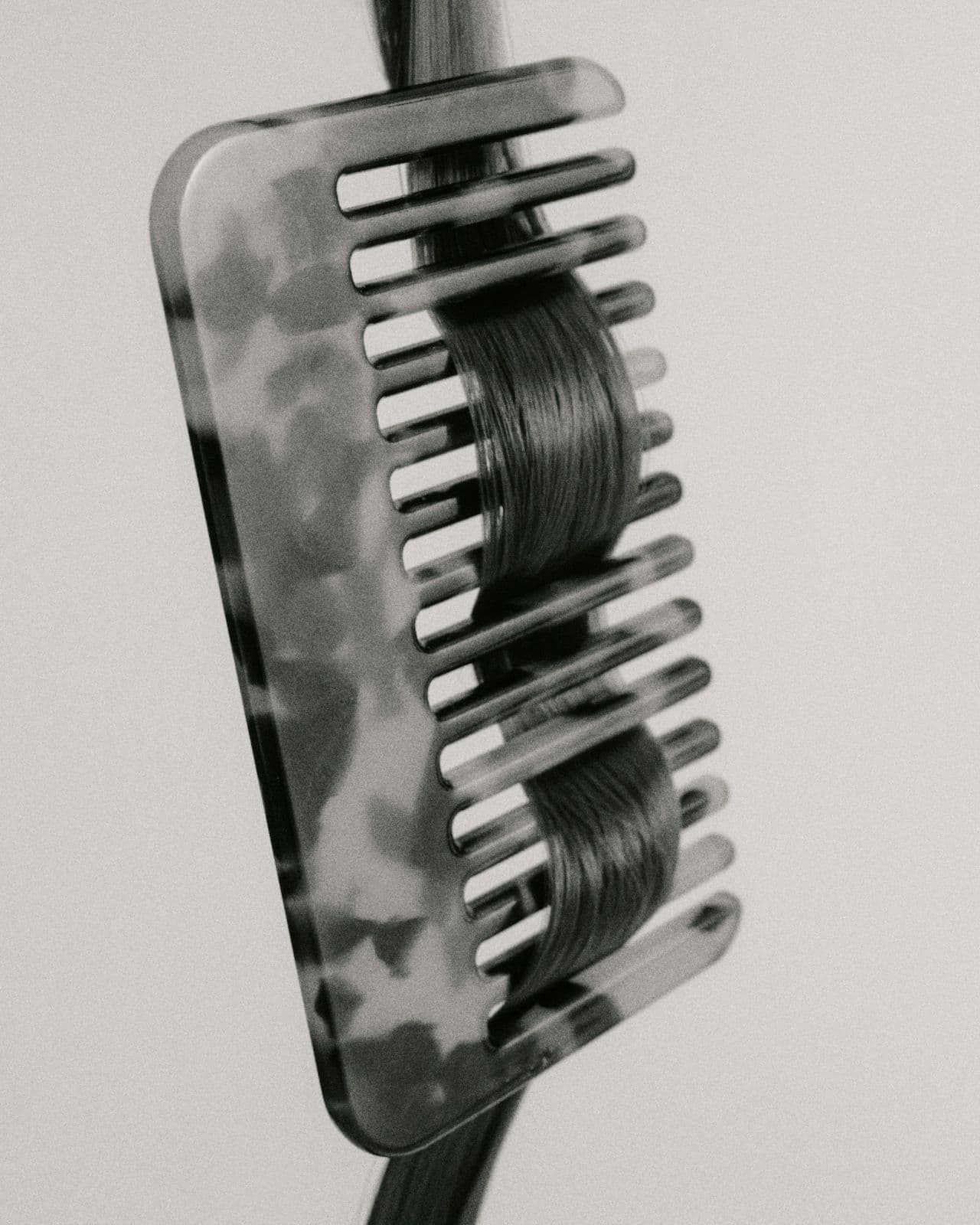Hair regrowth can feel like a time warp. All you want is your old hair back, but it can feel like waiting for paint to dry (surely your hair didn’t take this long to grow out after you cut that unfortunate bob a few years ago).
Emily DiGiulio, 24, lost her hair during chemo treatment for breast cancer in 2025. For her, hair loss felt sudden and emotional and now, slowly but surely, her hair is growing back. “It’s a lot easier said than done, but once you learn to embrace it, it becomes a lot easier,” DiGiulio says about her experience.
We’ve been there. We can tell you that it will likely grow back; but you don’t know exactly how. From the peach fuzz early days of regrowth, to managing different textures, here’s what to expect from your new hair.
So why does chemo make you lose your hair?
Dr. Jennifer Choi, an onco-dermatologist at Northwestern Medicine, says hair loss sometimes happens during chemo because the drugs are targeting rapidly dividing cells, which not only includes the cancerous cells you want to eradicate, but also your hair cells. Many women find they begin to lose their hair after one to three rounds of chemo.
When will it come back?
Your hair will most likely grow back—though it may take an excruciatingly long time. “A lot of people don’t realize that it can take three to six months for it to even start regrowing. Some people, they’re done with chemo and they’re like oh my gosh, why is my hair not regrowing, and it’s because the cells actually need time to recover,” Dr. Choi says.
And what will it look like?
For most, she says it will begin to grow back with peach fuzz-esque new sprouts. It will then slowly start to grow longer, but that timeline depends entirely on your hair’s growth speed.
It’s also very common for it to grow back an entirely new texture or color. Jenn Aédo, 42, had wavy hair prior to losing it during treatment for Burkitt Lymphoma, and as her hair’s been growing back, it’s super curly. Figuring out an entirely new type of hair to care for can be disorienting for many people.
Dr. Choi says we don’t exactly know why some women have what is often referred to as “chemo curls”, but it’s quite common.
In a recent study, Dr. Brittany Dulmage, an oncology dermatologist at Wexner Medical Center, and her colleagues interviewed Black women to better understand their experience with hair loss, and found that anecdotally, there’s a high report of women saying their hair grows in a different texture, although “chemo curls” are still common for women who start with all kinds of hair textures. “If you’re looking at it from above, the hair follicle is a circle and all around the circle may not start regrowing at the same time,” says Dr. Dulmage. “Parts may start regrowing slower or faster than the others, and so the texture may actually end up a little curlier or differently textured.”
Don’t neglect your scalp please!
Dr. Choi says keeping your scalp healthy is important, especially if your scalp is mostly bare in the early stages of hair regrowth. She recommends fragrance free cleansers, like the Dove Sensitive Skin, or a Cetaphil cleanser, as well as non-fragrance moisturizers and sunscreens. For some helpful recommendations, Jadey’s gentle skincare guide is here.
How do I care for my hair as it regrows?
During the earlier stages of hair regrowth, Dr. Dulmage says it’s important to continue practicing gentle hair care practices. You should avoid higher intensity chemicals on the scalp–like bleach coloring, and chemically relaxing hair–as well as to avoid heat exposure to your scalp. Check in with your team before coloring or any treatment like this.
You should continue to wash and condition your hair as frequently as you normally would. For shampoos and conditioners, Dr. Dulmage typically recommends something that’s fragrance free, because fragrances can be more irritating to your scalp, but says you generally don’t need to be worried about sulfates, parabens, or specific ingredients. “Sometimes [scalp cooling companies] advise patients to avoid sulfates and parabins, which could be a little bit more drying, but even those things aren’t super evidence based,” she says. “I think people should just be looking for things that are low in fragrance and that feel good to them when they use them.”
After the first six months of hair regrowth, your hair will likely have returned to a good density and thickness, so it’s typically appropriate to begin perming, straightening, coloring, or using heat tools on your hair, says Dr. Dulmage. If your hair hasn’t really grown back after six months, dermatologists would consider this “persistent chemotherapy-induced alopecia,” for which you may want to consult with a dermatologist for treatment options.
Some ways to boost hair regrowth (it’s mostly Rogaine):
In terms of helping your hair regrow, though, there are medications that are proven to help your hair grow back quicker and thicker, the most proven one being minoxidil (Always check with your medical team before using any new products during and post-treatment).
Dr. Dulmage says minoxidil, the active ingredient in Rogaine, has been shown to help your hair regrow about two months faster than if you don’t use it. She typically recommends the 5% foam or solution from Rogaine, because it’s available over-the-counter, but there are many other brands. 5% is typically marketed as a men’s product, but Dr. Dulmage says it’s proven to be safe for use in both men and women. She actually recommends the men’s option for women because sadly, yet unsurprisingly, there’s not too many differences between the men’s and women’s 5% minoxidil products, yet the women’s products can be more expensive.
There are few things to consider about which type of minoxidil you take; topical minoxidil works well, but it’s a little gunky to apply and can sometimes affect your hair color. Minoxidil also comes in pill form; it's very powerful, so powerful that hair can start to grow everywhere, not just your head; so if that’s something you don’t want to deal with, the topical option might be for you.
Dr. Choi also recommends minoxidil for eyebrow regrowth, but says you should avoid it on your eyelashes and instead try out a serum like Latisse, which has been proven to help your eyelashes grow quicker. As with all new products, it’s best to use them under the supervision of your doctor, particularly because Latisse can cause some side effects like permanent brown specs in the eyes, irritation, and thinning of the fat below your eyes.
She also says some oral supplements have been proven to be helpful for hair regrowth, though they’ve not yet been studied officially for post-chemo hair growth. Supplements like Nutrafol, Vivicscal, and Wellbel are options Dr. Choi recommends (which have had positive results in clinical trials)—but it’s important to run these by your oncologist because some have been shown to possibly interfere with estrogen inhibitors, which many breast cancer patients have to take for years after their treatment.
Accept that you’re going to be styling at every length (it can be sad and fun at the same time)
Every person’s experience with hair regrowth will be different.
Jenn Aédo, also a licensed hair stylist, says the awkward lengths and changing textures were the toughest parts of hair regrowth. “When it was shorter, it was almost easier because I could just edge everything down and it will look stylish. Now it’s kind of in the middle where the sides are growing out but the top part is the same length… it looks like a mullet no matter what I do,” she says.
Lauren McDermott, 22, who lost her hair during chemo treatment for breast cancer, says she’s tried to make the most out of each stage of hair regrowth. “Obviously there’s days where I’m like, oh my god, I would love to have long hair and curl my hair, of course, that really hits me,” Lauren says, “but seeing it grow in and seeing all of these new looks I’m able to work with has been super exciting and really contributed to this new kind of self love.”
It probably will not be fun all of the time, but if you’re able to embrace all the awkward lengths and new styles, it can make it just a bit less difficult.
Find a hair stylist who has experience working with women post-treatment
For these awkward lengths (what some like Aédo like to call the “chemo mullet”), or if you just don’t know what to do with your hair, you might consider going in to see a stylist who has experience working with women after cancer treatment. They can help shape your hair at any length as it regrows and give you more extra tips for thickening and accessorizing.
Diana Bottino, a hairstylist in New York who works with women as their hair regrows after chemo, says she typically has her clients come in more frequently so she can cut the back of their neck and tweak the shape. She doesn’t charge for a full haircut each time, and she says most stylists would probably do the same. These touch-ups can help you through the awkward lengths, and if your hair is growing back newly curly or wavy, your stylist can help you navigate this too.
They can also help you navigate your potentially thinner or newly curly hair. Bottino suggests a thickening hair mousse, specifically this one from R+Co called “Rodeo Star,” to help your hair look thicker if it’s styled. When it comes to “chemo curls,” Aédo recommends k18 hair oil to help keep your new curls moisturized, and the Bounce Curl brushes to help you style and work with the new texture. It’s all about trying new products and styles to see what works—something a hairstylist can help you out with.
Go wild with accessories and find your pixie/bob/boycut icons
Where she paid little attention to her hair before, Lauren now loves styling her pixie cut with little clips, zig-zag headbands, cloth headbands, head scarves, and wigs, and says it’s been fun drawing inspiration from Jamie Lee Curtis in Freaky Friday, and the female lead in The Matrix to style it with gel.
It’s all about trial and error. Try out new accessories that you wouldn’t have tried before, and try to have fun with adapting your new hair to your own personal style.
Sorry to report, patience is a keyword here
Your hair might grow back quickly, and it might not. There are things you can do to try and speed up the process, but the experts say being patient is the most important thing.
We know how tough it is to wait day after day for your hair to grow back to the way it was before treatment. Whether styling yourself with chic accessories or rocking a fresh new trim, finding ways to appreciate your hair at any length is ultimately the best way to approach the process of regrowth.









